#maggie cheung in the suit!!!
Explore tagged Tumblr posts
Text






Costume Design by Yuk-Ying Ho in The Seventh Curse [原振俠與衛斯理] (1986), dir. Lam Ngai Kai
18 notes
·
View notes
Text

1 note
·
View note
Text
New York Times Hidden Blade Review!
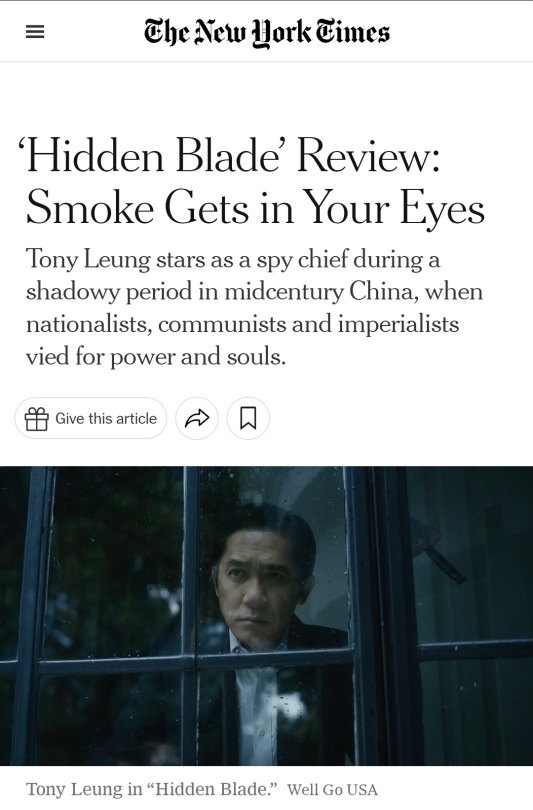
History’s shadow is long; so is the shadow of Tony Leung’s cigarette, which few other images in modern Chinese (Hong Kong) cinema can rival for iconographic force. To picture him smoking is to conjure an entire world of feeling — the aesthetic ecstasy of Wong Kar-wai distilled into a single vision. Perhaps only Bruce Lee’s fist or the Cheongsam sway of another Wong favorite, Maggie Cheung, compare.
Like many a neo-noirist, Cheng Er thrives in these shadows. They define his latest film, “Hidden Blade,” a puzzle-box action-thriller set amid the Second Sino-Japanese War (1937-45), during which communists, Chinese nationalists, Japanese imperialists and collaborators vied for power and souls: shadow warfare; shadow governments; and yes, a lot of deep-shadow photography of Leung, who plays a spy chief, looking amazing while smoking. (Then there is the shadow of Chinese communism, which raises tricky questions about the film’s politics.)
Impeccably coifed and suited, with his sad smile and careful manners, the simmering, mesmerizing Wang Yibo, who plays a young spy-assassin protégée (of whom, exactly, is a central question), is like a mirror to Leung from decades ago. That sense of homage appears deliberate; it serves the story in ways that aren’t merely meta-textual, and Cheng clearly honors the immense talent and cinematic history at his disposal.
read more
87 notes
·
View notes
Note
well now you know I have to ask.... top 3 sunmi looks and why.....
alright so one thing you have to understand about me and summi is… i’m usually not that impressed by how they style her for like stages/mvs tbh i feel like her stylists think well she is the most beautiful woman on earth so why do we have to try so much. like she always looks stunning obviously but that’s because she is literally sunmi and the clothes aren’t like BAD it’s just usually kind of boring. the one stage outfit i remember being truly truly wowed by is the suit-adjacent vest and tie ensemble she wore for stranger promotions

it had like everything. chic, sexy, interesting, great fit, concept. but anyways other than that i really always feel like. well babes i could style her so much better! and i am always so much more impressed by her personal style. so these are gonna be some faves from the sunmi model off duty archives.
1.



whenever she wears an oversized leather jacket i am sold tbh. like it just gets me. she already really has that specific star power to her look that i associate with certain 90s hong kong stars like joey wong and maggie cheung. and when she wears a leather jacket in that style it’s just like. that is a wkw muse. and if you know me at all well then you understand what that does to my psyche. middle outfit in particular might be my fave miyafit of all time.
2.


this little outfit that she wore to the germanier show last spring is sooooooooooo fucking good oh my god first of all no1 beret wearer ever she really knows how to carry what others might feel silly on. and the laceup matching set is so simple but the straight silhouette really suits her and i like that it’s extremely like. almost 90s calvin klein simple but then lacing gives you that little hint of lingerie-as-fashion. i love it soooo much.
3.


okay this is so like. idk what to say it’s just such a gay outfit like the menswear fit of the pants and the big navy ysl that looks like she probably stole it from her rich ivy league board member father before going to the hamptons- can you tell my taste was heavily influenced by watching gossip girl? idk she just looks so hot it’s STUPID.
ask me top 3 anything <3
2 notes
·
View notes
Text
Rules: Post 10 of your favourite movies and tag 10 people! Thanks @glamorouspixels for the tag. I’ve actually been thinking about this of late because I’ve listening to Brett Goldstein’s podcast Films To Be Buried With. These are in the order I watched them:
1. Lord of the Rings
My favourite films of all time, based on my favourite book of all time. Also I consider them to be one very long 11.5h movie (yes, I refer to the extended editions).
2. Chicago
One of the first movie musical adaptations I ever saw, which left an indelible impression on me. To this day I could probably describe the Cell Block Tango scene shot by shot. Catherine Zeta-Jones!
3. Once Upon A Time In Mexico
This bonkers finale to Robert Rodriguez’s El Mariachi trilogy has everything. It has Antonio Banderas as a brooding guitar-playing hitman. It has peak Johnny Depp in the era when it was not weird to have a Johnny Depp phase. It has Salma Hayek looking absolutely smoking. It has Enrique Iglesias, whose guitar has a flamethrower. It has Danny Trejo! Willem Dafoe! Eva Mendes! Mickey Rourke! all playing these absolutely unhinged roles. I adore it.
4. Sin City
So there are two Rodriguez films on this list, but I don’t think I could do without either. Sin City is perhaps one of the best graphic novel screen adaptations of all time. I was obsessed with this film from quite possibly too young an age, especially with Rosario Dawson as a dominatrix with a machine gun. It’s utter pulp and I’m not sorry.
5. Brick
I maintain this high-school neo-noir with baby Joseph Gordon-Levitt is still Rian Johnson’s best film, and this is despite the fact it was so low-budget they had to fake a transition by pulling a garbage bag over the camera and then playing it in reverse. It also contains a scene with a chicken jug that will live in my heart forever.
6. Singing’ in the Rain
Do they make them like this any more? They do not. I can’t begin to pick what I love most about this - the hysterically funny script, the OT3 vibes, the fact that nearly every musical number is a colossal achievement of its own (Donald O’Connor running up the walls in Make ‘Em Laugh! The tap-dancing in Moses Supposes! Cyd Charisse in that green dress in Broadway Melody!) or even just the comic genius of Jean Hagen, which could sustain an entire film on its own.
7. Inception
This film managed somehow to be both a cinematic masterpiece and fandom catnip, which is rare. As an architecture/urbanism geek who also loves heists and devastatingly competent men in suits, I feel like this film was made for me. Also, Arthur/Eames! One of my all-time ships.
8. 28 Days Later
Best second-generation zombie film, for my money - both stunningly shot and horrifying. The way the final mansion massacre is filmed while John Murphy’s soundtrack builds on that eerie four-note crescendo - chills. Also, young Cillian Murphy and Naomie Harris! really the most beautiful zombie film ever.
9. The Maltese Falcon
I dithered over whether to put this or The Big Sleep in the bracket of “classic book-to-film noir adaptation starring Humphrey Bogart” - I love them both equally - but went with this because it is, marginally, the better film (and the better book - Raymond Chandler could write the hell out of a novel but he could not tie up his plots). It also has the fantastic villain duo of Peter Lorre and Sydney Greenstreet, as well as a young Elisha Cook Jr as the gunsel who gets played for a sap. That ending! “If they hang you, I’ll always remember you.”
10. In the Mood for Love
This is, hands-down, the greatest film on this list. Definitely one of the greatest films ever made. Every single shot is a work of art. That iconic scene of Maggie Cheung buying noodles in a dark high-collared cheongsam, walking down a smoky alleyway swinging her tingkat to the strains of the plaintive violin of Shigeru Umebayashi’s theme, brushing past Tony Leung in his steam-rumpled suit - it gives me shivers. I’ll never be over the ending of this film. I’ll also never be normal about buying noodles.
So I’m not going to tag 10 people because I’m too tired but like talk about your favourite movies if you want to!
9 notes
·
View notes
Note
I must ask the mod:
Do you have voice headcanons and/or claims for your characters?
Alright! This one's gonna be a doozy for ya girl here because it seems like in any AU I put my main OCs in, I have to really make sure that their voices suit how they sound in my head as well as their mannerisms and what languages they use (the language I try to do my best with, but it mainly comes down to the sound of the voice more than anything). In this case, I think only Feng and Tamara get their usual Voice-Claims which will be listed in this post because they ALWAYS sound a certain way to me that I can never seem to let go of.
Unfortunately, because of my dumb ass messing up the format of this post, I’ll have to put links to video clips or even audio clips instead ^^;; Sorry, everyone!
I’m gonna put the rest of the stuff under the cut because... Oooooh, it’s a bit of a mess. I’m so sorry!
--
Kyung's Voice-Claim: CoCo Lee
English Speaking: (X)
Cantonese (I’m pretty sure it is, I think...) Speaking: (X)
Fun fact: Originally, I was going to go with Kelly Chen, mainly for her singing voice in her rendition of “Reflection” from Mulan due to it sounding more like how I would imagine Kyung’s singing voice would be like in this AU, but I’m glad I did some more digging! I love CoCo Lee’s energy, her laugh and how she can sound a little more silly at times!
--
Shinju’s Voice-Claim: Maggie Cheung
English Speaking: (X)
Cantonese Speaking: (X)
Fun fact: I’m quite happy that I dug more for this one rather than just going with Lucy Liu like I had originally planned. Her regular speaking voice is honestly perfect when I imagine how Shinju speaks in this AU!
--
Feng’s Voice-Claim: Kevin Michael Richardson
(Primarily his role as Captain Gantu from Lilo & Stitch)
Gantu clips: (X)
Fun fact: I genuinely tried to find a proper Cantonese actor that sounded close enough, but goddamnit- It’s hard finding voices with that distinct gravelly baritone I always imagine Feng talking in.
--
Tamara’s Voice-Claim: Angela Bassett
Audio Sample Compilation (it’s the same VC as she has in the Oddworld!AU and in the “Mainverse”): (X)
Singing Sample: (X)
Same Voice-Claim for the most part, except I’m deciding Tamara won’t need a designated singing VC like her other AU counterparts.
--
Luka’s Voice-Claim: Michael Fassbender
English and German Sample: (X)
French Speaking Sample: (X)
UUUUUUGGGGGGHHHHH- This one gave me a lot of hell. So, as much as Luka is fluent in Cantonese in this AU, he’s a primarily English speaker with his native language being German, his secondary being French, and him being able to do decent Spanish. I was also VERY picky about how the voices sounded because Luka, in my mind, sounds a little more higher-pitched and gentle in a way.
Fun fact: I was originally going to go with Timothée Chalamet because his English and French give me more Luka vibes, but I think it’s mainly because of how much of a hilarious dork the dude is.
--
Lee’s Voice-Claim: Harry Shum Jr. (Speaking), Li Yugang (Opera/Singing)
English and Cantonese Sample: (X)
Opera/Singing (Decided to go with this vid since he sings both is his regular male voice, and the one he uses for his Dan roles): (X)
Li Yugang also played as Consort Yu in his performance of Farewell My Concubine here: (X) Li Yugang appears at the 2:28 mark.
I think the only problem I ran into was getting super specific on trying to find Cantonese Opera actors who performed Dan roles, which seemed to leave me with nothing, or just circling around back to Peking Opera or general Chinese Opera as a whole. QQ
Fun Fact: I was originally going to just go with the usual VC I have for him (Aurelio Voltaire), but because of the setting the AU takes please (it being more historical) and given his career as a Chinese Opera performer, I had to really dig for this one. I would have gone with the famous Mei Lanfang, but it was even more difficult to find good samples for my notes. That being said, I at least found a pretty good clip of Mei Lanfang both singing and speaking in a Dan role: (X)
12 notes
·
View notes
Text
I can't believe it's been nearly a full year since Dara released this piece!! I've had it on my desktop every day since. I'm so happy it anticipated Kill Code! I figure it might be nice to finally share the reference picture I gave to Dara when trying to describe what I was looking for:

A screenshot from wuxia film 'Hero' (2002), featuring Tony Leung and Maggie Cheung. I will always have a crush on Tony Leung and Dara managed to perfectly nail the vibe, while entirely suiting it to Rev and Loba. Thank you again so much Dara!

💀❌🐺 commissioned by m_mechanica on twitter
#apex fanart#apex legends#apex legends fanart#revenant#loba#apex revenant#apex loba#loba andrade#revenant apex legends#kofi commission#apex legends revenant
143 notes
·
View notes
Text
Hong Kong fashion icons in 1997
Back in 1997, Hong Kong's fashion icons were performers who dominated the music stage or big screen, like queens of Canto-pop Anita Mui Yim-fong and Faye Wong, or Wong Kar-wai's long-time muse Maggie Cheung Man-yuk.
Whether in performance or daily life, these celebrities brought bold, avant-garde looks as well as simpler, trendy pieces to the forefront of Hong Kong fashion, popularising everything from androgynous suits to casual low-rise jeans.
Faye Wong
Singer and actress Faye Wong emerged in the early 1990s after she moved from mainland China to Hong Kong and started singing in Cantonese (she would later revert to her native Mandarin).
With the aid of long-time stylist Titi Kwan, she became known for wearing daring pieces, including a chandelier dress made from Swarovski's crystal fabric, Jeremy Scott's sole-less heels, and even a see-through dress paired with a black sweater crop top and knitted underwear.
Offstage, Wong adopted a boyish look for the film Chungking Express (1994), in which she was seen in striped tees and oval sunglasses, while in day-to-day life, she wore loose and flowy grunge outfits.
(SOURCE)
19 notes
·
View notes
Text
Two kinds of people like Olivier Assayas' Irma Vep. I am going to describe them to you, but I will tell you why I am doing it at the bottom of this article. So, there are plenty of people who claim that the minor intrigues in Irma Vep produce the type of quality entertainment you would get from most of Arnaud Desplechin's films. What type of entertainment would this be exactly? Well, Desplechin is arguably the greatest successor of Jacques Rivette, so most everything he does fits into the comedie dramatique genre, which is the French variation of our soapy melodrama. However, the French tend to play with a wider range of 'serious' themes in their comedie dramatique films and this is usually the reason why our mainstream critics see them differently and find them more appealing. So, you will be entertained with plenty of intellectual chatter sprinkled with different flavors of humor which will occasionally be disrupted by the 'serious' themes that will introduce the necessary drama. According to some fans of Irma Vep, Assayas infused his film with this classic blend of comedie dramatique which makes it entertaining. Now, there are also plenty of people who find Irma Vep attractive for a very different and actually very simple reason. The reason is Maggie Cheung wearing a tight latex suit that looks almost as sexy as the one Michelle Pfeiffer put on in Batman Returns. You would never hear these people discuss the intellectual chatter in Irma Vep because to them it is nothing but a smoke screen, which is why they see right through it. The few scenes where Cheung steps in front of the camera and temporarily becomes that famous character from Les Vampires validates the existence of Irma Vep. As far as the people that I am describing to you are concerned, it is utterly irrelevant whether the film is good or bad. They are just content that it exists in its current form.
Of course, there are just as many people that dislike Irma Vep, and it is actually very easy to understand why. Here are a couple of reasons:
[...]
Here's the promised revelation about the two groups of people that like Irma Vep: they don't see the film differently. They are both attracted to it because of the footage with Cheung doing her part in the weird remake. But only the people from the second group have the courage to admit it.
why is this man so bitter...... just say you dont get it and go????
6 notes
·
View notes
Photo
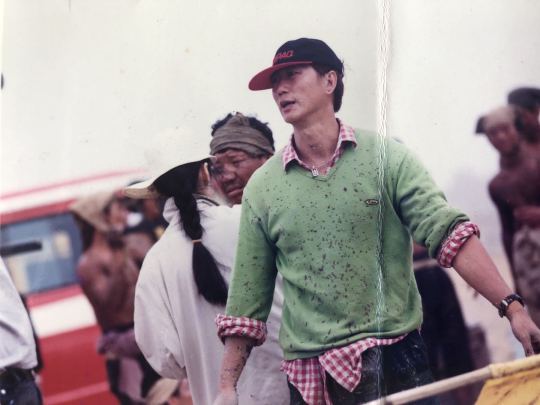

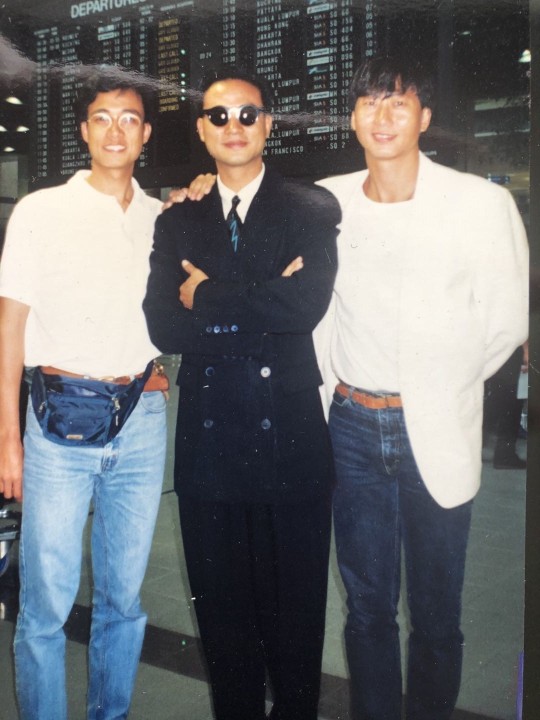
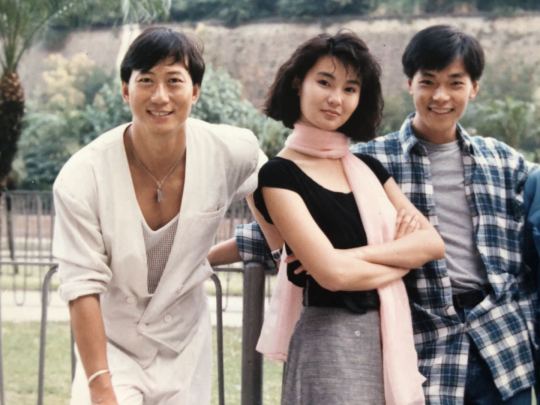

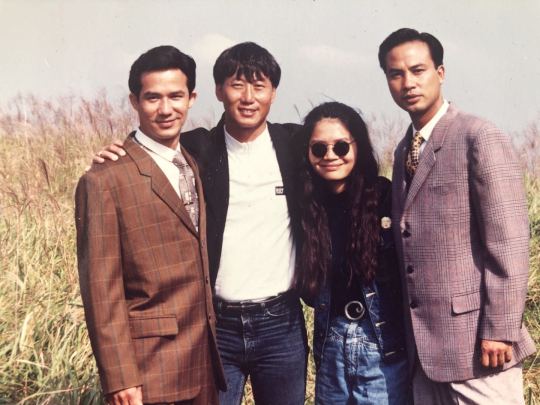
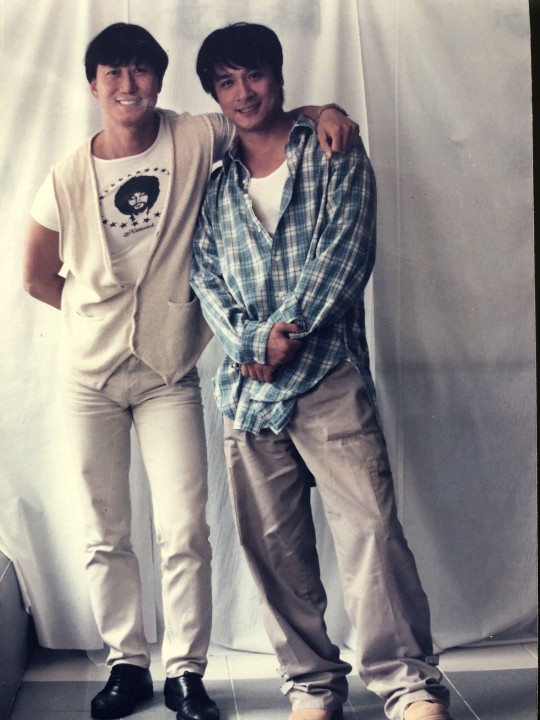
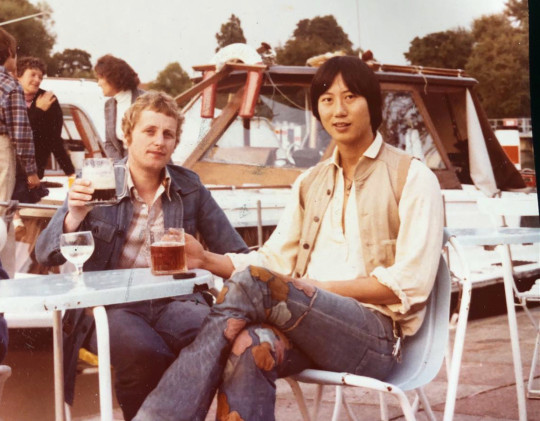
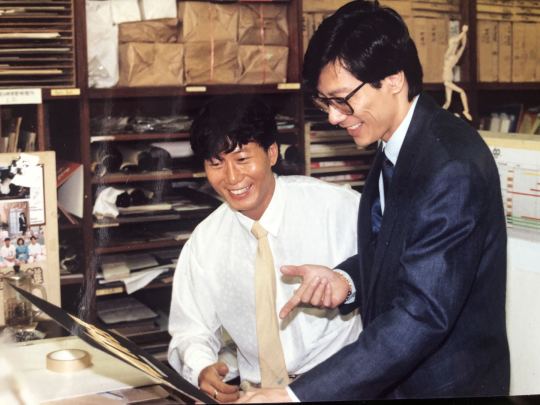

“Stars, Too, Were Time Travellers. The 4 Great Stars That I Have Worked With And Salute.” ——The Respected Film Art Director Of Hong Kong Bill Lui
In film, an ‘Art Director’(美術指導)works directly below the ‘Production Designer’(美術總監) and a large part of his duties are the administrative aspects of the art department. The Production Designer is the superior individual responsible for the overall look and tone of the film project. He works with the art director, set dresser, prop master and cinematographer to accomplish the director’s artistic vision of the film.
The former Chairman of Hong Kong Film Arts Association Bill Lui(雷楚雄) is a kind and helpful friend who always tries to lighten the burdens of other people. He was a great Art Director and is now an adored Production Designer working in the Mainland and Hong Kong.
Inside each of us is a natural-born story listener. I asked Bill, “Any good story to share from your interesting career?” Bill replied, “Maurice, you like to encourage people. Let me cite 4 charming actors whose heart-piercing supports to me are always unforgettable. They are, in the order of their seniority, Josephine Siao(蕭芳芳), Simon Yam(任達華), Maggie Cheung(張曼玉) and Nicolas Tse(謝霆鋒). As an ‘art controller’ in the film-making process, my judgements are based on my personal opinions and tastes but they can be very subjective. I am glad that the above good actors did tell me the other side of the coin, namely facts and angles that I might not have fully considered.”
“Josephine Siao was special because she was like a walking dictionary or caring mentor, probably due to the fact that she became an actress in 1953 when she was only 6 years old. She is also a film director. She is the jack of all trades and ‘master of all’ as well. In one movie, she had to play the role of a Cantonese opera actress. She went backstage to observe the opera actors for more than 10 evenings and took a note of all the suggestions that she intended to propose to me. I still remember her putting on a super-powdery and overpowering perfume on a film set. I was shocked and asked her why. She smiled, ‘Bill, it is the preferred scent of the Cantonese opera actresses and I do think the strong smell can help the other actors accepting me as the character in the film!’” said Bill.
Josephine Siao has been my lifelong idol——I never thought of anyone as a super movie star until I watched her film I love a Go-Go (我愛阿高高) in 1967!
I asked Bill, “I guess Simon Yam is the male version of Josephine Siao?” Bill laughed, “Not exactly. In the 70s, Simon was a fashion model, later a TV star and progressed to become a successful film actor in Hong Kong. Josephine was eager to serve others and Simon is helpful to the art direction of a film in a different way. He is more an independent perfectionist in everything he did. Whenever I knew Simon was in the cast, I had nothing to worry about him. He himself was a designer cum artist. I recall that in a film about a high society gigolo, Simon proposed to me, ‘Bill, I know your limited budget but such a gigolo will surely wear Giorgio Armani or Jean Paul Gaultier. Could I contribute half of the money needed and we go together to buy such brands to make the character more graphic.’ After this proposal, I saw him also dashing up to a gym to make sure that his body will look sexy to match the role.”
I probed, “Is Maggie Cheung like Simon?” Bill moved his head, “Maggie showed her support to an art director by listening to him. She gave me a lot of freedom to combine all the ingredients for her role. She said only one thing, ‘Bill, I trust you will take good care of all the stuff and see to it that all will pertain appropriately to the role. Do not care about if I look better or worse. It is not my concern. I will be very accommodating if the film can become better!’”
Raised in Britain, Maggie Cheung started her acting career after placing second in 1983’s Miss Hong Kong Pageant. She won the ‘Best Actress’ award at Cannes Film Festival in 2004. 90% of the Chinese population can say out her name loud. It is a pity that she is now semi-retired.
I asked, “Bill, the youngest is Nicolas Tse who is now about 40. What is he like?” Bill shared his thought, “Perhaps both his parents were good actors and he had learnt what professionalism should mean since his childhood. He joined the movie world at 16. He is too proficient in the dos and don’ts. Courage is doing what you are afraid to do. Youth is being not afraid to do. These two explain why whenever I asked Nic to do something exciting, he always answered, ‘Why not? Let me have a go!’ The world is fast changing and trends on art are forever moving too. I explore new ideas and I need unique stars like Nic telling me that he is willing to experiment with me. For me, Nic is more a ‘co-working partner’. He is now very popular in the Mainland and deserves such an outcome. Nic shows the difference between a star and an actor. A star will say, ‘How can I change the fix to suit me?’ An actor will say, ‘How can I change myself to suit the fix?’ Nic is incredibly clever.”
The possibility of a dream, the dream of making unreal into real, is the force inspiring art directors to do better and finer. If an art director is the painter, his stars cannot just be the canvas. They are interactive. A professional art director who works hard not because of his or her status or remuneration, but the ethical obligation under which the best in a film has to come together!
MLee
Interview with Josephine Siao Acknowledgement: RTHK https://youtu.be/I1znTY-06nk
Simon Yam Movie Acknowledgement: Filmko Pictures https://youtu.be/_TRyoxt7Rvk
Maggie Cheung Movie “Clean” Acknowledgement: youtube https://youtu.be/jj_o-onUIWA
Nicholas Tse Movie “Invisible Target” Acknowledgement: Universe Entertainment Ltd https://youtu.be/t-c8mxI2oTU
#Bill Lui 雷楚雄#Art Director#Production Designer#Josephine Siao 蕭芳芳#Simon Yam 任達華#Maggie Cheung 張曼玉#Nicolas Tse 謝霆鋒#Perfectionist#I love A Go-Go#Gigolo#Giorgio Armani#Jean Paul Gaultier#Miss Hong Kong Pageant#Cannes Film Festival#Making Unreal Into Real
4 notes
·
View notes
Photo

Movies I watched this week / 7
One of my favorite films of all time, Wong Kar-wai‘s exquisite and repressive In the Mood for Love: Maggie Cheung and Tony Leung’s sad love story set in Hong Kong of 1962 - 10/10
Yumeji's Theme. (Re-watch).
✴️
David Byrne's new American Utopia, a minimalist, joyous concert film, that includes a moving version of Janelle Monae’s Hell You Talmbout. Directed by Spike Lee. Regarding that last credits scene, I just read that Byrne had always used a bike as his main means of transport throughout his life.
✴️
So how does it compare to the infectious Stop Making Sense, “one of the greatest concert films of all time”? Why compare them at all?
“Everyone is trying to get to the bar / The name of the bar, the bar is called Heaven”... (Re-watch).
Here’s David Byrne's Giant Suit Emporium Commercial.
The proudest moment of my blogging life was back in 2008 when David Byrne started following my Grow-a-Brain blog.
✴️
Another masterly Jonathan Demme re-watch: Silence of the Lambs, which 30 years later is now experiencing some push-back as transphobic. I couldn’t see it that way, but what do I know.
With favorite character actor Tracey Walter as Lamar.
✴️
Human Nature, Michel Gondry‘s surprisingly bizarre philosophical first film, with a script by Charlie Kaufman. How could I never even heard of it before?
✴️
Easy Riders, Raging Bulls, a fascinating documentary of how the young generation of Hollywood movie ‘brats’ of the ‘60′s and ‘70′s changed the industry, for a while. I read the book, and didn’t realize that there was also a movie. Now i want to watch all of these movies again.
✴️
Funny sketches Zinc Oxide and You and Cleopatra Schwartz from Kentucky Fried Movie, one of John Landis and The Zucker brother’s first films.
“With Donald Sutherland as the clumsy waiter “.
✴️
Turning Tide, a short film about a 10 year old boy who witnesses a large aerial battle over 1940's Scotland.
How the filmmakers creatively made this epic WW2 movie with practically no budget.
✴️
Supernova, about an elderly gay couple who takes one last road trip as Stanley Tucci’s dementia becomes too hard to manage. A moving drama but way too simple.
✴️
Election Night, a 1998 Danish short about racism directed by Anders Thomas Jensen.
✴️
Judas and the Black Messiah, a new Daniel Kaluuya vehicle about the betrayal of Fred Hampton. Another story about entrenched racism and injustice. Too depressing.
✴️
Kristen Wiig’s brand new, unfunny “comedy” Barb and Star Go to Vista Del Mar - 2/10.
✴️
On the other hand, Uncle Buck has scenes like the “Where do you live?” and “Honey, I have some bad news” which was copied verbatim by the “Daddy, I have to poop” scene in “People Places Things”. (Re-watch).
Ever hear of a ritual killing?
✴️
Bad Education - Investigating corruption. Based on a true events, but it’s not exactly Spotlight.
- - - - -
Throw-back to the art project:
Talking Heads Adora.
Silence of the Lambs Adora Poster.
- - - - -
(My complete list is here)
1 note
·
View note
Text

0 notes
Text
I watched Irma Vep with Maggie Cheung for the first time a few days ago and it literally consisted of her running around in a skin tight black cat suit outfit.. 10/10 would recommend
1 note
·
View note
Text
Why I love Maggie Cheung’s performance in Irma Vep
A number of pleasant exceptions emerge throughout Olivier Assayas’ 1996 film, Irma Vep. First and foremost, Chinese actor Maggie Cheung stands out as the central character – playing herself – in the French production of a film within a film. To witness an Asian star carrying the weight of the title character spoke volumes back then considering the reality of today: Asian actors represent one per cent of Hollywood’s leading roles.
And, arguably, Irma Vep plays out like a dual valentine to French cinema and to Cheung herself – not only from Assayas, who was romantically involved with his lead during production, but also from the film itself, in which the fictional director and costume designer are both enamoured with Cheung. It’s easy to see why: Irma Vep wouldn’t be what it is without Cheung, who slips perfectly into the character’s black bodysuit (more on that iconic look later).
The story unfolds in Paris, where Cheung arrives later than expected and jet-lagged from Hong Kong. She finds herself in a film exec’s office where tensions are running high: the camera follows a production team frantically trying to source funding for Irma Vep. After seeing her action films in Morocco, the director of the film, René Vidal (Jean-Pierre Leaud), casts Cheung as Irma Vep – an anagram of vampire – in a remake of the classic 1915 Louis Feiullade series, Les Vampires.
“You can be Irma Vep because you have the grace,” he admits to her enthusiastically during their first meeting, echoing a statement Assayas once made about Cheung: “[She is] an up-to-date version of an old-fashioned movie star.”

Indeed, Cheung straddles present and past seamlessly, mixing silent era poise with mid-’90s cool. During this time, French cinema struggled to rediscover its identity amidst the force majeure of American movies. As costume designer Zoe (Natalie Richard) tells Cheung, “I don’t like American films. Too much decoration. Too much money. But why? For what?” As the self-styled auteur Vidal, Leaud personifies the French New Wave. Meanwhile, Cheung is an outsider who barely speaks French, adding unconventional charm to this playful plot. As the three-day shoot gradually descends into chaos, she remains a picture of calmness as she rolls with the punches of the disgruntled crew.
This is further evidenced in the sex shop scene where Zoe fits Cheung for her skin-tight latex suit (inspired by Michelle Pfeiffer’s Catwoman costume in Batman Returns). As she’s zipped in, the transformation from Cheung to Irma Vep is nearly complete. And this despite the disorder all around her: Zoe’s chain-smoking; conversations which aren’t translated for her; and constant fussing over the outfit. All the while, Zoe’s affection for Cheung grows.
Back in her hotel, Cheung cuts a bored and lonely figure. Sonic Youth’s ‘Tunic (Song for Karen)’ foreshadows a rebellious and subversive act: “Goodbye Hollywood,” Kim Gordon sings, as Cheung finds herself in Irma Vep’s clothes, prowling the halls and stalking the hotel staff and guests. Cheung sneaks into another woman’s room and steals some jewellery that’s dangling from the bathroom sink. After slinking away, she takes the loot to the roof and tosses it to the ground, literally taking meta-method acting to new heights. Where does Cheung end and Irma Vep begin?
Shortly after, Vidal has a nervous breakdown and is replaced by a decidedly more patriotic director, José Mirano (Lou Castel). He removes Cheung from the starring role and casts a French actor named Laure (Nathalie Boutefeu) as Irma Vep. How could anyone else be Irma Vep other than Maggie Cheung? (This question equally applies to the upcoming eight-part TV remake starring Alicia Vikander.)
It doesn’t matter at this point. Cheung leaves Paris to meet with Ridley Scott in New York. In real life, the actor would later garner international critical acclaim in future roles such as In the Mood for Love and Clean. Life has a funny way of imitating art.
The post Why I love Maggie Cheung’s performance in Irma Vep appeared first on Little White Lies.
source https://lwlies.com/articles/maggie-cheung-irma-vep-performance/
0 notes
Note
Film asks - 9, 16, 21!
from the Film Ask Meme 9. The most aesthetically pleasing movie you’veever watched?
For beauty it’s hard to beatWong Kar-wai’s In The Mood for Love. Maggie Cheung as Mrs. Chan in dozens ofgorgeous cheongsams, Tony Leung as Chow, the picture of 1960s smoothness insuits and slicked back hair. The two of them sit across from one another inrestaurants while Nat King Cole sings in Spanish, never quite touching but sodamn close. The reds are dark and luscious, the greens are almost blue, the twoleads are so gorgeous and all you want them to do is kiss and it’s just onelong, painful sigh of UST.
16. A film you love but everyone else hates?
Oh man, back when it came outI loved the hell out of The English Patient and all my friends HATED it, likepassionately. My best friend at the time and I were having some problems and Idragged him to the movie and it was the final straw. It was one of those thingswhere sitting next to someone hating something makes you start seeing it withtheir eyes and it was painful. I felt like I’d made him scrub his face withscorpions.
I recognize that I have ahigh tolerance for lush, fatalistic, borderline ridiculous WWII-era romance andanyone that hangs with me has to accept this fact or bounce.
21. A film with an amazing soundtrack?
Morvern Callar. The soundtrack is a mix tape left behind for theprotagonist of the film so each song, classic jams by Can, Stereolab and NancySinatra & Lee Hazlewood, are another message, guiding the story to its nextturn.
Thank you, @purficklyclean!
7 notes
·
View notes
Text
Femmes Fatales
Programmer Blue Velvet (David Lynch, 1986) suite à Qui veut la peau de Roger Rabbit ? (Robert Zemeckis, 1988) est avant tout l’occasion d’explorer la piste du film noir. Ces deux films, contemporains l’un à l’autre, réactualisent et modernisent différemment les codes du genre. Et qui dit film noir dit souvent... femme fatale. Chez Zemeckis, c’est Jessica Rabbit, qui grâce à l’animation pousse à l’extrême l’incarnation de la femme fatale. Avec Dorothy Vallens (Isabella Rossellini) dans Blue Velvet, David Lynch hyper-sexualise et entoure d’une aura particulièrement violente et tragique cette figure.

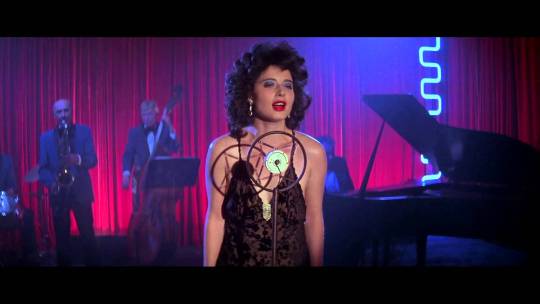
Ces deux personnages nous ont furieusement donné envie d’évoquer, d’interroger les femmes fatales au cinéma. Car elles sont indéniablement plurielles : en réfléchissant sur cette idée de dossier, il est apparu que personne n’a le même imaginaire lié aux femmes fatales, tant celles-ci sont liées à des moments cinéphiles très particuliers.
Evidemment, incontournables sont les femmes fatales des films noirs de l’âge d’or hollywoodien. Incarnées par Lauren Bacall, Rita Hayworth, Joan Bennet, Barbara Stanwyck - entres autres - elles représentent l’archétype de la femme fatale.
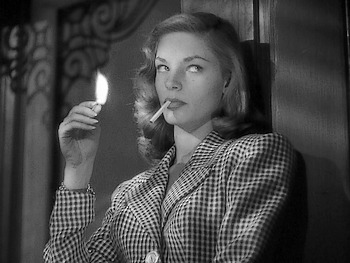
Mais, les femmes fatales sont-elles uniquement un archétype du film noir ? Chez Bleu 439, on pense plutôt que ce genre est venu nourrir tout un pan du cinéma (tout le cinéma?), et que les femmes fatales, si elles sont indissociables du film noir, existent bien au-delà de celui-ci. Et elles n’ont pas non plus attendu sa naissance pour exister…
Dans la littérature, d’Homère (les sirènes, Circé) à Sader Masoch (La Vénus à la Fourrure) ou dans l’imaginaire collectif (les sorcières au Moyen-Age), émergent ces figures de femmes extra-ordinaires.
De cet héritage, on les imagine tentatrices, séductrices et poussant (généralement les hommes) au vice. Dans L’Ange bleu (Josef Von Sternberg, 1930), Lola (Marlene Dietrich), danseuse dans d’un cabaret mal famé, amène un vieux professeur à la folie. Dans All about Eve (Joseph L. Mankiewicz, 1950), Eve (Anne Baxter) joue la fausse ingénue pour s’immiscer dans la vie de Margo (Bette Davis) et prendre sa place.
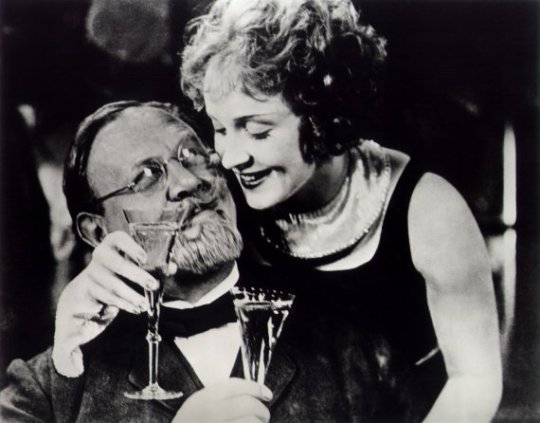
Reste à savoir si les femmes fatales usent forcément de manière consciente de leurs charmes. Dans Mulholland Drive (David Lynch, 2001), Rita (Laura Elena Harring) est une femme fatale malgré elle, dans le regard de Betty/Diane (Naomi Watts).
Car les femmes fatales, ce sont aussi une puissance de représentation. Dans Laura d’Otto Preminger (1944), un policier chargé de l’enquête d’une disparue est fasciné par son portrait.
D'une féminité exacerbée , elles fascinent mais sont souvent inaccessibles. A l’image de Jessica Rabbit, adulée par tous, n’a d’yeux que pour son Roger… Ou de Maria (Ava Gardner) dans La Comtesse aux pieds nus (Joseph L. Mankiewicz, 1954) à qui l’on reproche de ne pas être capable d’aimer. Quand finalement elle tombe amoureuse d’un homme, celui-ci ne peut la satisfera, et la mènera à sa perte..
Ces femmes sont souvent enfermées dans leur rôle de femmes hors-normes, qui suscitent l’admiration, les menant souvent à une fin tragique.
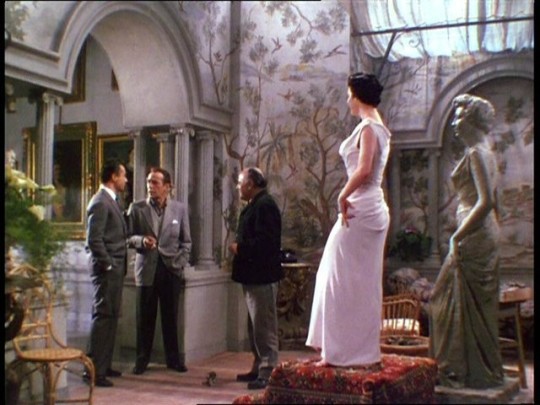
Revenons à Bleu 439. Au cours de nos discussions, nos pensées sont allées aussi bien vers Maggie Cheung chez Wong Kar-wai, Shu Qi chez Hou Hsiao-hsien avec Milenium Mambo), que vers certaines héroïnes de Verhoeven, De Palma, Lynch, voire même Ferrara. En passant par certaines figures du muet (Georgette Leblanc dans L’Inhumaine, Brigitte Helm dans Metropolis), Lola Montès de Max Ophuls, Karaba dans Kirikou de Michel Ocelot, Isabella (Gong Li) dans Miami Vice de Michael Mann, Satine (Nicole Kidman) dans Moulin Rouge, certains rôles de Kim Novak, et bien d’autres.
Sans pouvoir écrire sur toutes ces femmes fatales, Bleu 439 s’est mobilisé pour tenter (de manière forcément subjective) de montrer à la fois leurs pluralités et leurs singularités, en décryptant certains de ces personnages si particuliers. Tout au long du mois, des articles seront publiés ici.

Bonne lecture !
Lola pour Bleu 439
#dossiers#femme fatale#femmes fatales#Roger Rabbit#jessica rabbit#isabella rossellini#blue velvet#film noir#lauren bacall#rita hayworth#david lynch#ava gardner#marlene dietrich#laura
3 notes
·
View notes